Case Summary: Patient Information
- 65 year-old male patient;
- difficulty breathing due to heart failure;
- objective and subjective data gathered by the nurse;
- intervention plan and expected outcome outlined by a multidisciplinary team;
- goals: enhance patient care delivery, avoid readmission within 30 days, improve the quality of life.
A 65-year-old man presents to the emergency department with difficulty in breathing due to heart failure. During the assessment phase, the nurse gathered both objective and subjective data about the real and possible clinical issues for the patient. The involved healthcare team developed their intervention goals, care objectives, interventions for the goals and objectives, and the expected outcomes. The goals and objectives were conceptualized to enhance patient care delivery through a multidisciplinary team to improve care coordination, eliminate the need for hospital readmission within 30 days after the discharge, and to improve the patient’s quality of life (McAlister, Youngson, & Kaul, 2017).
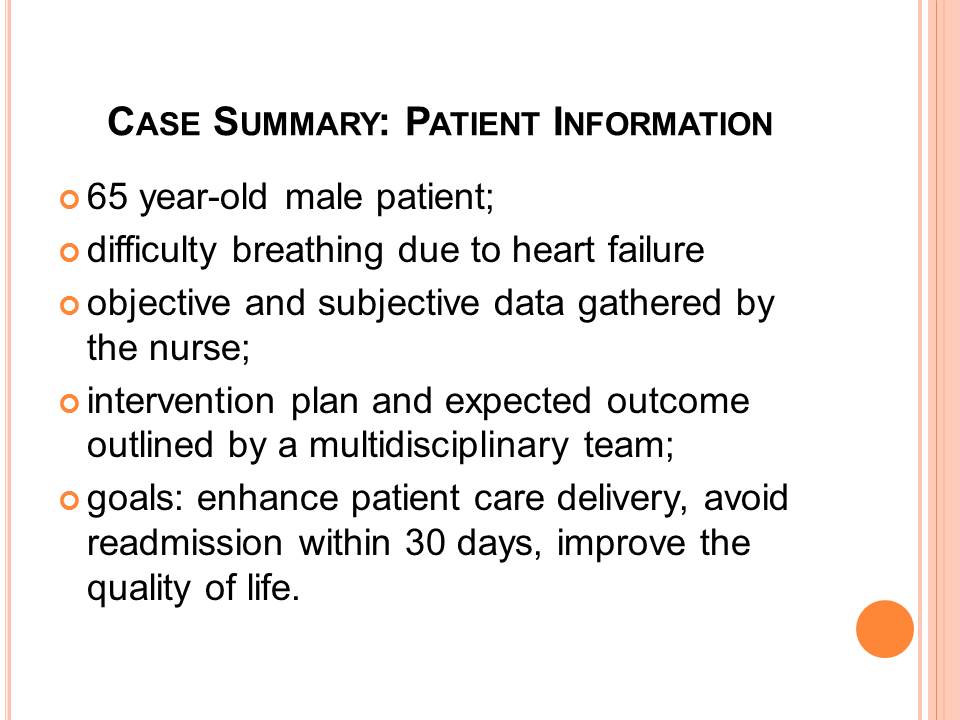
Case Summary: Care Provided
- assessing vital signs (pulse patterns, blood pressure, respiration, oxygen saturation, and body temperature);
- changes in the patient’s life style, changes in diet, medication administration, and oxygen therapy;
- diet modifications (diets low in salt and rich in energy and vitamins);
- medications (digitalis, diuretics, ACE inhibitors, digoxine, and furosemide);
- chest X-rays, laboratory blood tests, and Electro-Cardio Graph tests.
- assessing vital signs (pulse patterns, blood pressure, respiration, oxygen saturation, and body temperature);
- changes in the patient’s life style, changes in diet, medication administration, and oxygen therapy;
- diet modifications (diets low in salt and rich in energy and vitamins);
- medications (digitalis, diuretics, ACE inhibitors, digoxine, and furosemide);
- chest X-rays, laboratory blood tests, and Electro-Cardio Graph tests.
Interventions were focused on assessing vital signs (pulse patterns, blood pressure, respiration, oxygen saturation, and body temperature), changes in the patient’s life style, changes in diet, medication administration, and oxygen therapy. Care coordination and patient and family health education were also used.
Dieticians were also involved in diet modification for the patient. Diet was critical in improving patient quality of life and intervention outcomes. Diets low in salt and rich in energy and vitamins were recommended.
Physicians prescribed medication and other therapies for the patient, and nurses were responsible for the administration of the prescribed drugs and therapies. Some of the drugs prescribed for the patient included digitalis, diuretics, ACE inhibitors, digoxine, and furosemide (Amakali, 2015). The patient underwent chest X-rays, laboratory blood tests, and Electro-Cardio Graph tests.
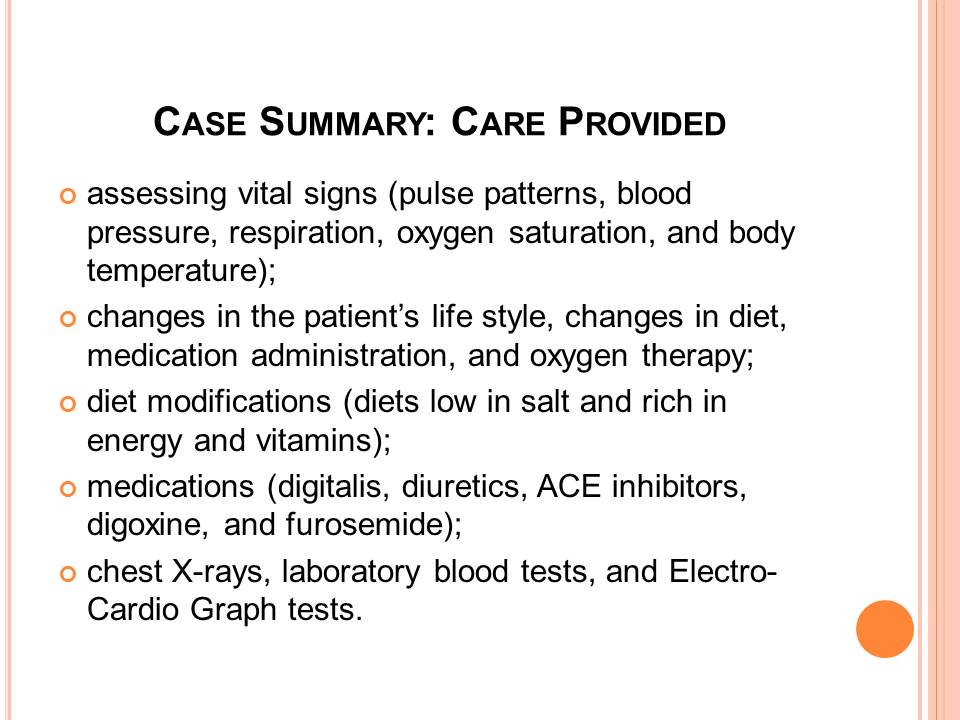
Case Summary: Education Provided
- focused on behaviors, activities, and emotions to reduce heavy workload on the heart;
- highlighting self-monitoring, changes in lifestyle, moderate physical activities, self-administration of medications, diet modifications, and adherence to follow-up treatments;
- informing about reduced circulation, systemic output, and hypoxia for self-monitoring;
- monitoring of difficulties in breathing and or edema;
- the education included changes in risky behaviors and lifestyle, diets, engaging in physical activities, and emotional stability.
Patient education was focused on behaviors, activities, and emotions to reduce heavy workload on the heart. Patient education highlighted self-monitoring, changes in lifestyle, moderate physical activities, self-administration of medications, diet modifications, and adherence to follow-up treatments.
The patient was informed about reduced circulation, systemic output, and hypoxia for self-monitoring. Thus, he was most likely to experience dizziness, palpitation, weakness, shortness of breath, and other related symptoms. The patient, therefore, had to observe possible difficulties in breathing and or edema. Additionally, patient education also included changes in risky behaviors and lifestyle, diets, engaging in physical activities, and emotional stability. Further, the patient had to adhere to medication and treatment regimen without fail during self-care (White, Kirschner, & Hamilton, 2014).
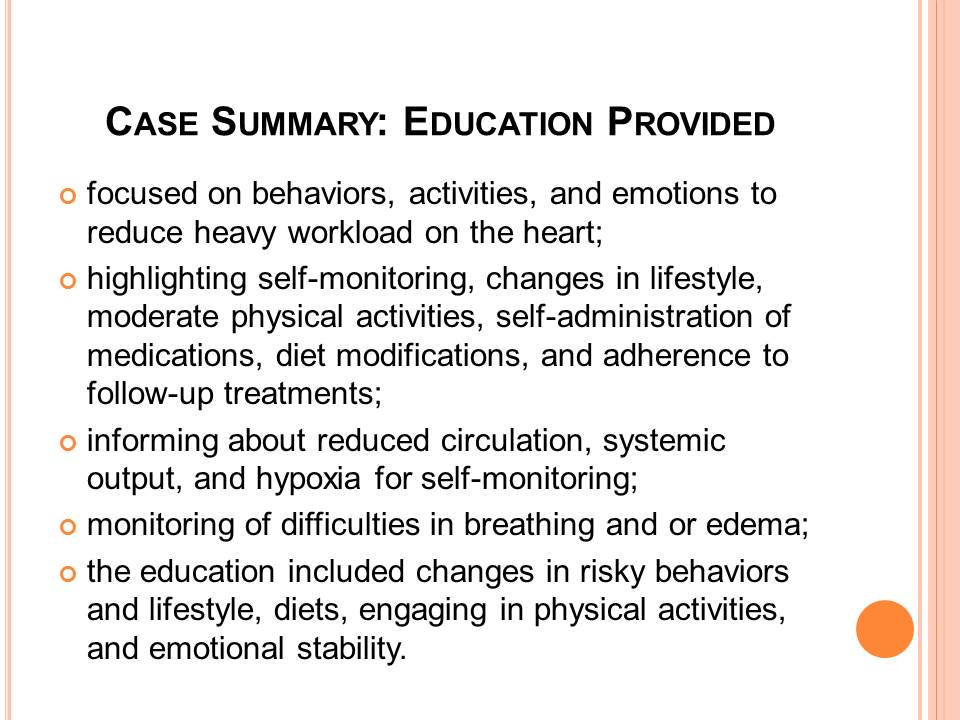
Quality Indicators
3 groups:
- structural indicators (nurses’ skill level, staff supply, education and certification levels);
- process indicators (assessment and interventions);
- outcome indicators (patient outcomes resulted from medical care).
Those addressed in the case study:
- patient satisfaction with nursing care;
- patient satisfaction with overall care;
- patient satisfaction with medical information provided.
- safety level;
- food and nutrition;
- drug administration.
Quality indicators can be divided into 3 major groups:
- structural indicators (nurses’ skill level, staff supply, education and certification levels);
- process indicators (assessment and interventions);
- outcome indicators (patient outcomes resulted from medical care).
- Among all the existing indicators, the following ones were addressed in the given case study:
- Patient satisfaction with nursing care. The patient was totally satisfied with the provided care since the nurse in charge provided effective healthcare coordination.
- Patient satisfaction with overall care. All the members of the multidisciplinary team ensured the provision of high-quality services, which satisfied the patient.
- Patient satisfaction with medical information provided. The information was detailed and complete.
- The level of safety. The patient was provided with the highest level of safety.
- Food and nutrition. The patient followed his personal diet.
- Drug administration. The nurse monitored that the patient took all the necessary drugs.
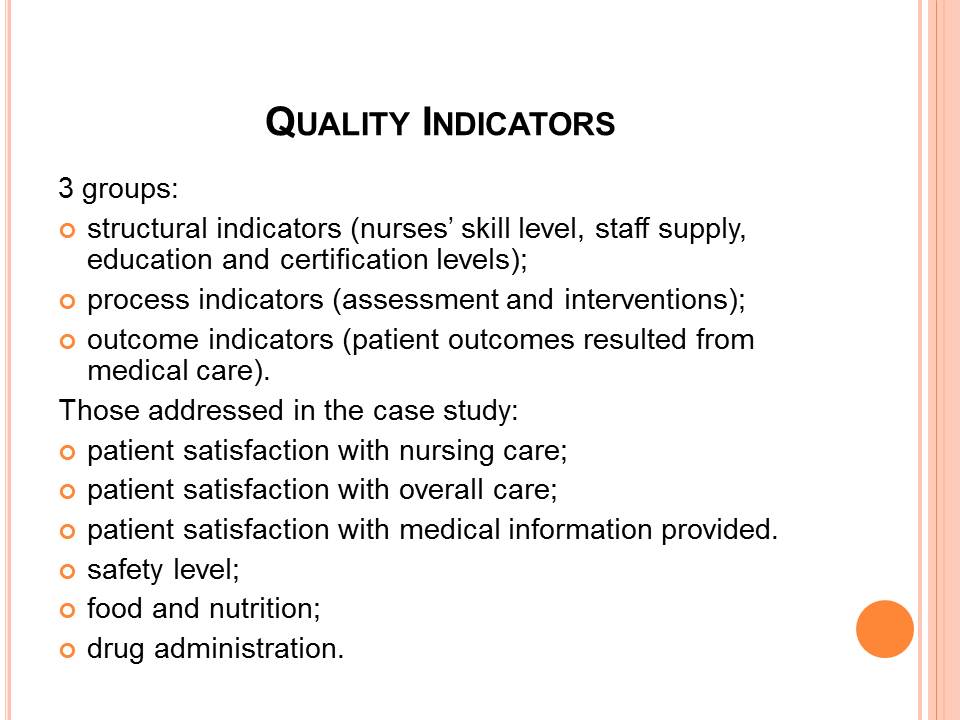
Measuring Safe and Effective Care
- demonstrative in terms of showing nurse-sensitive outcomes;
- allow measuring safe and effective care by assess how well healthcare providers manage to demonstrate high-quality performance;
- generate meaningful information on the patient’s condition.
- make it possible to predict mistakes.
Quality indicators are highly demonstrative in terms of showing nurse-sensitive outcomes. They allow measuring safe and effective care by assessing how well healthcare providers manage to demonstrate high-quality performance for achieving their goals. In this given case-study, quality indicators generate meaningful information on the patient’s condition: the level of safety, quality of diet, and patient satisfaction at all levels will determine how well the patient will cope with the consequences of his disease. Moreover, quality indicators make it possible to predict mistakes that may produce a detrimental impact on the future development of the disease.
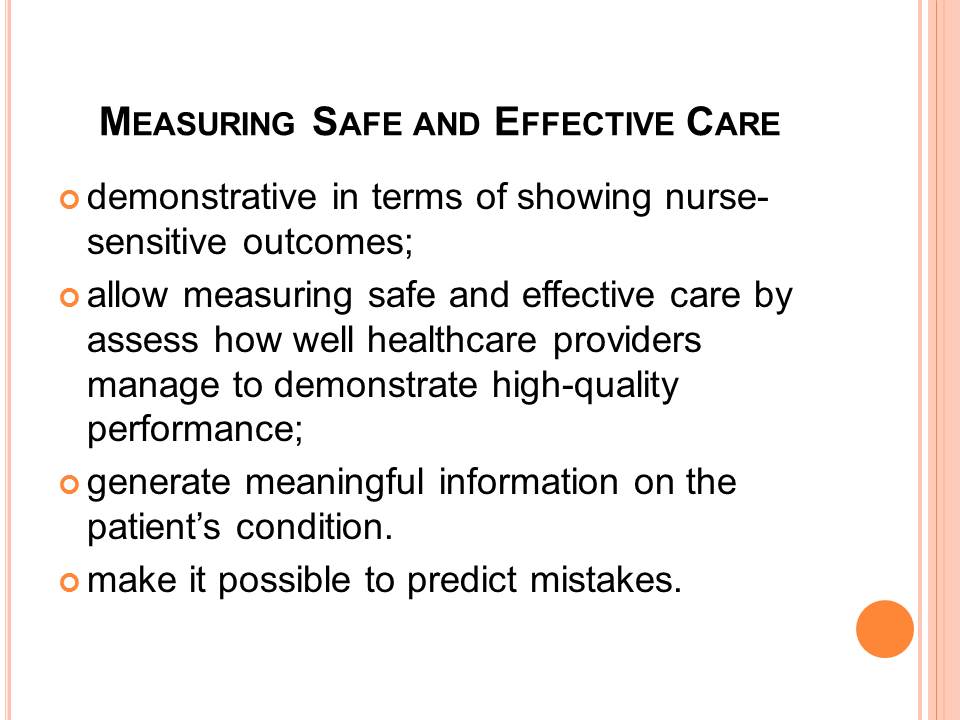
Patient Safety Issues
- excess activities to restrict strains on the heart;
- noise and to manage his emotions, polluted air environments to limit chances of hypoxia;
- smoking (active or passive) and alcohol consumption;
- the risk of ischemic heart conditions;
- to reduce pressure exerted on the heart by food;
- heart failure drugs.
There are a lot of safety issues involved in the case. The major ones are connected with excess activities to restrict strains on the heart. The patient was advised to avoid noise and to manage his emotions, as well as polluted air environments to limit chances of hypoxia. Further, it was recommended to quit smoking (active or passive) and alcohol consumption. Otherwise, the condition of the patient could aggravate dramatically. Another safety problem was connected with the risk of ischemic heart conditions. Foods were prepared soft to limit mechanical digestion processes and to enhance metabolic activities. The patient was advised to consume meals in small quantities and to ensure a semi-Fowler position to reduce pressure exerted on the heart. Moreover, heart failure drugs could cause adverse effects.
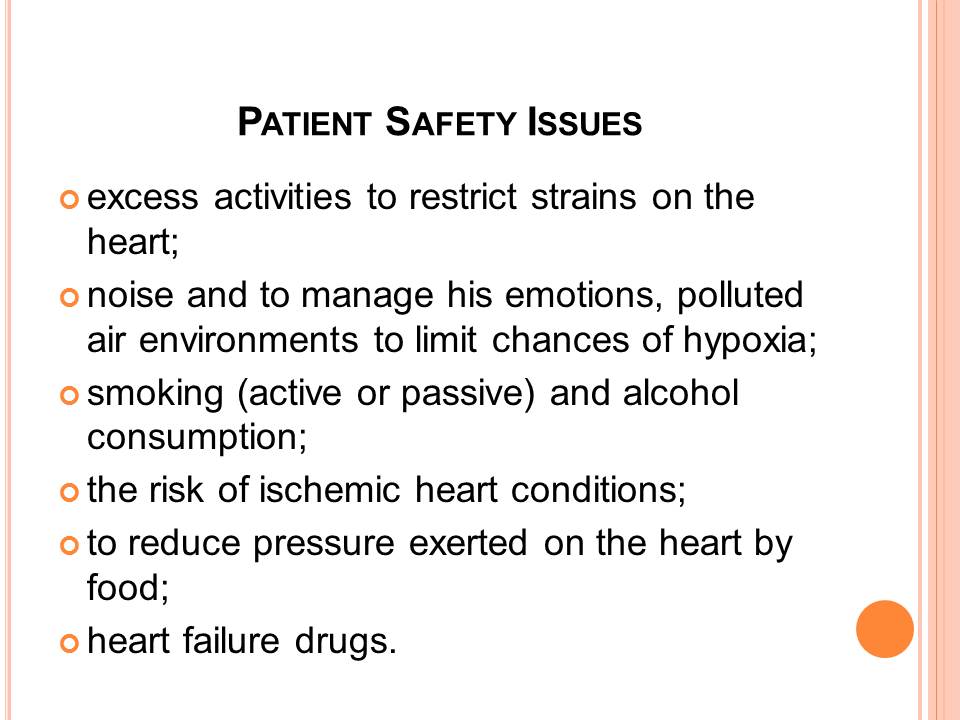
Quality Improvement Processes
The first significant quality improvement process is connected with prevention of communication errors that result in poor outcomes and readmissions. Daily rounding must be reconsidered to make it more effective. Staff members often think that meetings are formal and do not contribute to the actual care provision. However, it is the only possibility to consider opinions of all the team members and discuss the plan of care. That is why rounding should be made more detail- and experience-oriented.
Patient safety can also be improved with standardization. Cross-diagnosis and cross-setting pathways are required to standardize treatment. Individual variation makes it too challenging to assess which interventions are the most effective. With clinical pathways, professionals can use evidence-based precedents to simplify handling of each case.
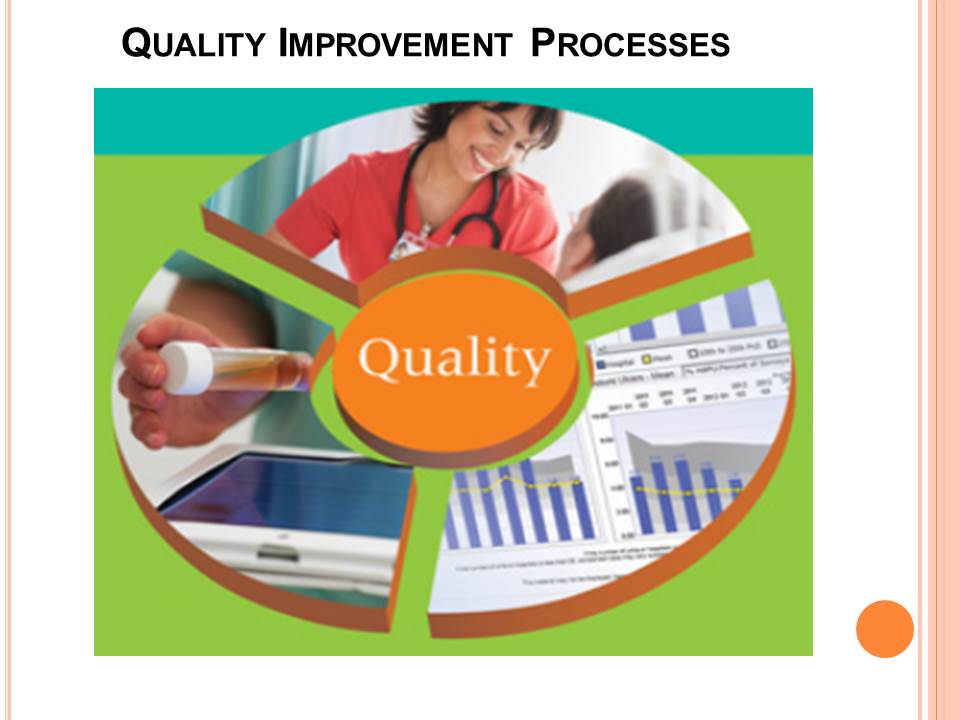
Quality Improvement Intervention
The best solution for quality improvement in the given case is follow-up. Since the patient is new on the prescribed drugs, it is highly important to track whether he has any complications. The nurse who was in charge of his care in the hospital should be responsible for this. He/she must monitor if the patient follows all the prescribed rules of dieting and medications.
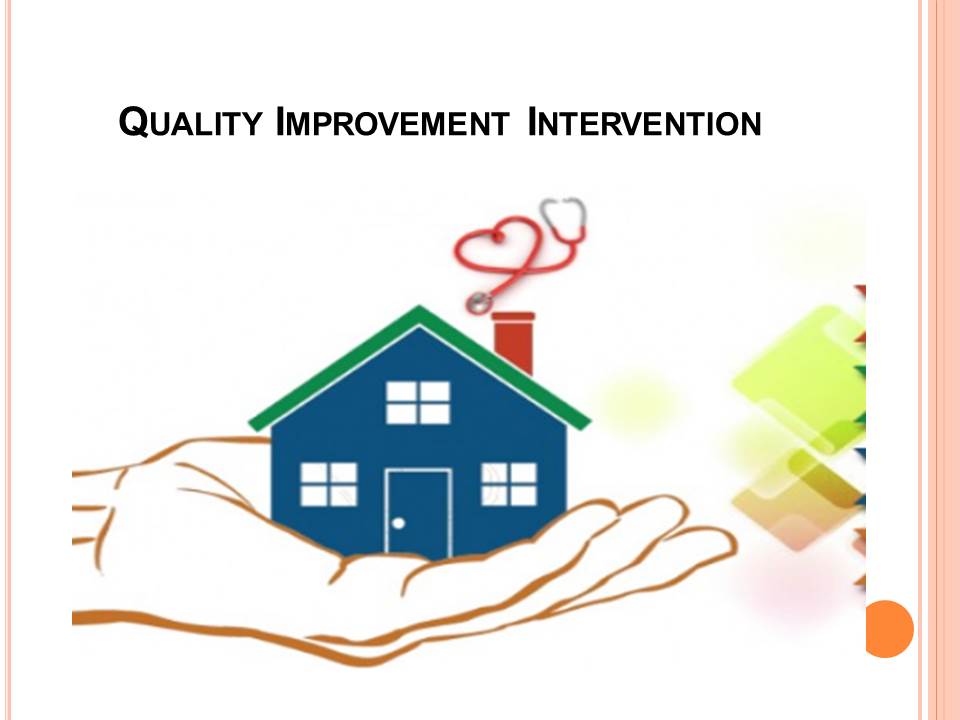
References
Amakali, K. (2015). Clinical care for the patient with heart failure: A nursing care perspective. Cardiovascular Pharmacology, 4(2), 142.
McAlister, F. A., Youngson, E., & Kaul, P. (2017). Patients with heart failure readmitted to the original hospital have better outcomes than those readmitted elsewhere. Journal of the American Heart Association, 6(5), e004892.
White, M. F., Kirschner, J., & Hamilton, M. A. (2014). Self-care guide for the heart failure patient. Circulation, 129(3), e293-e294.